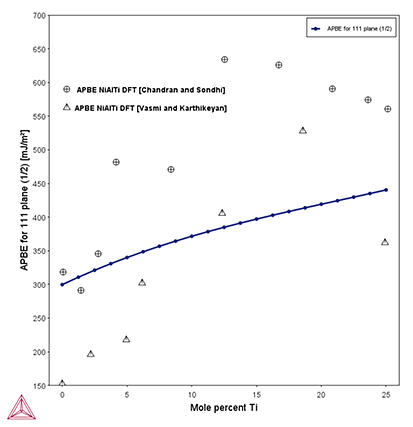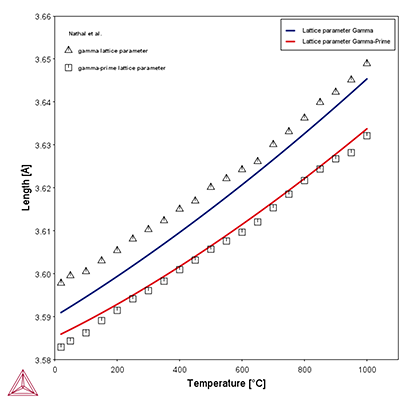Ni合金向けプロパティモデル
Thermo-CalcソフトウェアのアドオンモジュールであるNi合金向けプロパティモデルでは、逆位相境界エネルギー、粗大化の速度定数、凍結温度での平衡特性の計算が可能です。GUIのProperty Model CalculatorかTC-Pythonにて各計算を実施できます。本モジュールの使用には、TCNI11およびMOBNI5以降のライセンスが必要となります。
- 逆位相境界エネルギー
Ni基合金における析出相γ’ 相の逆位相境界エネルギー(Antiphase Boundary Energy)を計算できます。このモデルは“Miodownik et al. (1995)”、“Saunders et al. (2000)”、“Crudden et al. (2014)”、“Liu et al. (2018)”に基づいています。計算例:PM_Ni_02: Antiphase Boundary Energy of γ’

Ni3Al1-xTixにおける (111) 面の逆位相境界エネルギー(DFT計算との比較)
- 粗大化の速度定数
球状の析出物を仮定して、母相からの1つ以上の析出物における粗大化の速度定数を計算できます。このモデルは“Anderson et al. (1992)”と“Morral et al. (1994)”に基づいています。 - 凍結温度での平衡特性
指定した凍結温度で平衡計算を行った際の組織を保ちつつ、異なる温度での材料特性を評価します。相界面散乱を考慮した電気抵抗率は、散乱係数と全ての相の体積分率の相互作用の和の積で評価されます。熱伝導率への寄与はウィーデマン・フランツの法則に従って電気抵抗率への寄与と関係していると仮定されています。計算例:PM_Ni_01: Lattice Parameter of γ/γ'

Ni-0.6Mo-0.92Ta-12.5Al-1.83Ti-10.5Cr-3.3Wにおけるγ/γ’ 相の格子定数(実験値との比較)
参考文献
- 逆位相境界エネルギー
- D. J. Crudden, A. Mottura, N. Warnken, B. Raeisinia, R. C. Reed, 2014. “Modelling of the influence of alloy composition on flow stress in high-strength nickel-based superalloys.” Acta Materialia. 75: pp. 356–370.
- Y.-X. Liu, Y. . Lin, 2018. “A Yield Stress Model for a Solution-Treated Ni-Based Superalloy during Plastic Deformation.” High Temperature Materials and Processes. 37: pp. 849–856.
- A. P. Miodownik, N. J. Saunders, 1995. “The calculation of APB energies in Ll2 compounds using a thermodynamic database” in “Applications of Thermodynamics in the Synthesis and Processing of Materials,” P. Nash, B. Sundman, Eds. (TMS, Warrendale, PA, 1995), pp. 91–104.
- N. Saunders, M. G. Fahrmann, C. J. Small, 2000. “The Application of CALPHAD Calculations to Ni-Based Superalloys.” Superalloys 2000 (TMS, Warrendale, Pa., 2000), pp. 803–811.
- 粗大化の速度定数
- J. O. Andersson, J. Ågren, 1992. “Models for numerical treatment of multicomponent diffusion in simple phases.” Journal of Applied Physics. 72 (4): pp. 1350–1355.
- J. E. Morral, G. R. Purdy, 1994. “Particle coarsening in binary and multicomponent alloys.” Scripta Metallurgica et Materialia. 30 (7): pp 905–908.
- 凍結温度での平衡特性
- R. Franz and G. Wiedemann, 1853. “Ueber die Wärme-Leitungsfähigkeit der Metalle.” Annalen der Physik. 165 (8): pp. 497–531.
- T. M. Tritt, 2004. “Thermal Conductivity: Theory, Properties, and Applications.” New York, Boston, Dordrecht, London, Moscow: Kluwer Academic Publishers-Plenum Publishers.














